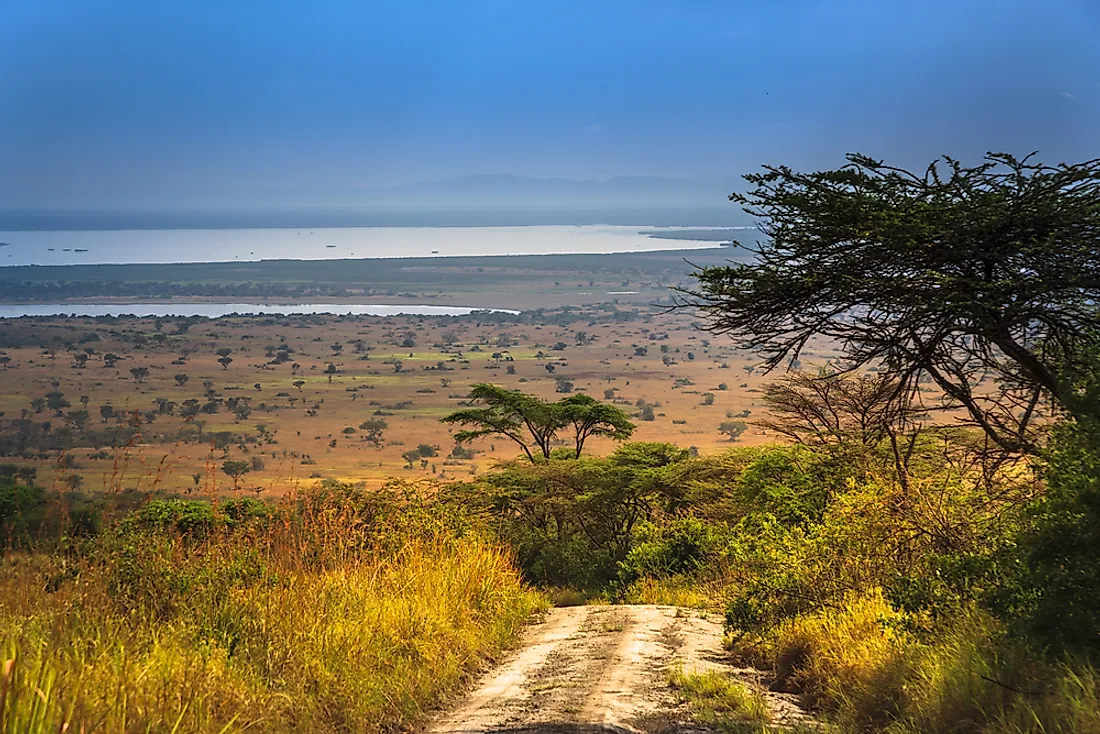The Western Or Albertine Rift Valley Lakes

Lakes in the Albertine Rift or Western Rift of the East African Rift are the deepest, oldest, and largest of the Rift Valley Lakes. These lakes are also referred to as the Central African lakes. Lake Victoria, although not a rift valley lake, is located in a depression between the western and eastern rifts. With an area of 59,947square km, Lake Victoria is Africa’s largest lake and the world’s biggest tropical lake. Lake Victoria and two lakes of the Albertine Rift (Lake Edward and Lake Albert) are part of the basin of the mighty Nile River. All lakes in the Albertine Rift valley are freshwater in nature and they host a great diversity of species.
4. Lake Albert
Lake Albert, the 7th biggest lake in Africa, straddles the Uganda-DRC international border. It is the northernmost lake in the Albertine Rift and has a surface area of 5,300 square km. The maximum length and width of the lake are 160 km and 30 km respectively. It has an average depth of 25 m and is located at an elevation of 619 m. The Semliki River and Victoria Nile are the primary sources of water for Lake Albert. Swamps exist at the southern end of Lake Albert where the Semliki River drains into the lake. Mountains of the Ruwenzori Range form the backdrop further south. In recent years, oil finds in the lake have opened up numerous opportunities to exploit the same.
3. Lake Edward
The smallest of the African Great Lakes, Lake Edward is also located in the Albertine Rift. Like Lake Albert, it also extends across Uganda and the DRC and is protected by Uganda’s Queen Elizabeth National Park and DRC’s Virunga National Park. Lake Edward covers an area of 2,325 square km. It has a maximum length and maximum width of 77 km and 40 km respectively. The surface of Lake Edward is at an elevation of 912 m and it has a maximum depth of 112 m. Several rivers like the Nyamugasani, Ishasha, Rutshuru, and others feed the lake. The Semliki River drains the lake and flows into Lake Albert. The region around Lake Edward is a volcanic zone with several volcanic features. Several fish species are found in the lake. The surroundings are extremely rich in fauna like chimpanzees, elephants, lions, etc. Hundreds of species of resident and migratory birds are also found in the lake region.
2. Lake Kivu
Lake Kivu is an African Great Lake located on the Rwanda-DRC border. It is the continent’s eighth largest lake. It has a maximum length and width of around 90 km and 50 km respectively. The surface area of the lake is approximately 2,700 square km. The surface of Lake Kivu is at an elevation of 1,460 m. It has a maximum depth is 475 m and an average depth of 220 m. In terms of mean depth, it is the world’s ninth deepest lake. Idjwi, one of the largest lake islands in the world is located in Lake Kivu. Only 28 species of fish reside in this lake. It also hosts two species of endemic freshwater crabs.
1. Lake Tanganyika
Lake Tanganyika, another lake in the Albertine Rift, is the world’s second-oldest, second deepest, and second-largest by volume. The massive lake is shared by four countries DRC, Burundi, Zambia, and Tanzania. However, 40% and 46% of the lake’s area is possessed by DRC and Tanzania, respectively. This lake has a maximum length and maximum width of 673 km and 72 km respectively. It has a surface area of 32,900 square km. It is located at an elevation of 773 m and has a maximum depth of 1,470 m. The Ruzizi River is the main river feeding the lake. Lake Tanganyika’s water flows into the Atlantic Ocean via the Lukuga River of the Congo River system. Lake Tanganyika has alkaline waters and is stratified. The lake thrives with wildlife like Nile crocodiles, terrapins, Storm's water cobra, cichlid fish, several species of mollusks and crustaceans, and more. Lake Tanganyika is very important to the local economy and supports a major fishery.











